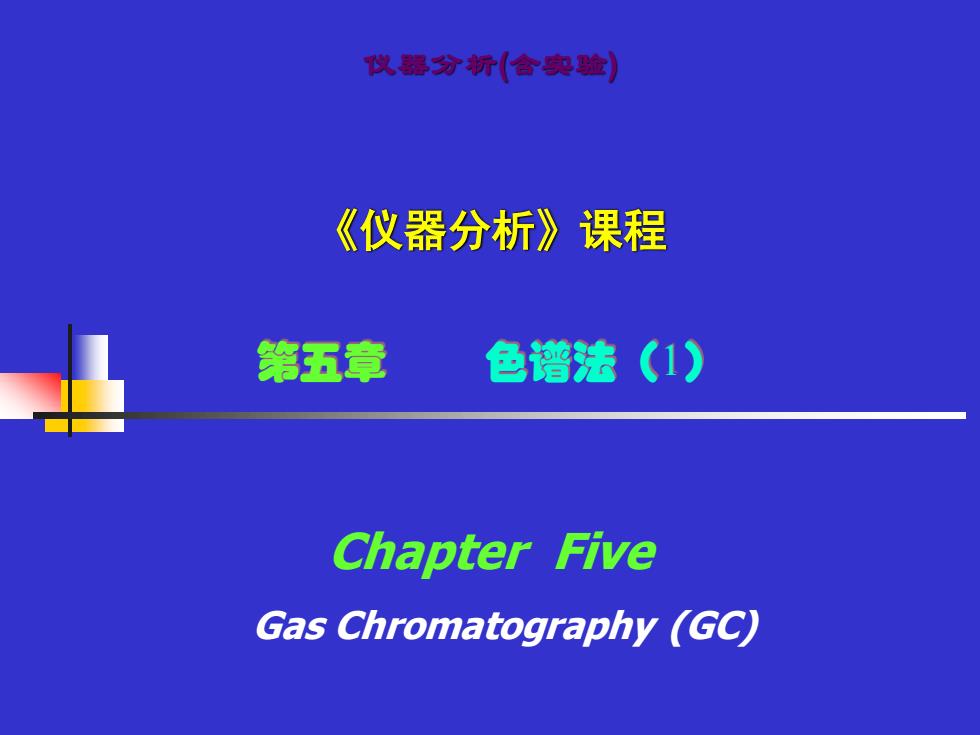
积器分折合奥拉 《仪器分析》课程 第五章 色谱法(1) Chapter Five Gas Chromatography (GC)
《仪器分析》课程 Chapter Five Gas Chromatography (GC) 第五章 色谱法(1) 仪器分析(含实验)

色谱法Chromatography Contents in 10 hours of study I色谱法的基本原理 Common Concepts and Principles of Chromatography II 气相色谱法 Gas Chromatography (GC) 工高效液相色谱法 High Performance Liquid Chromatography (HPLC)
色谱法 Chromatography Contents in 10 hours of study I 色谱法的基本原理 Common Concepts and Principles of Chromatography II 气相色谱法 Gas Chromatography (GC) III 高效液相色谱法 High Performance Liquid Chromatography (HPLC)
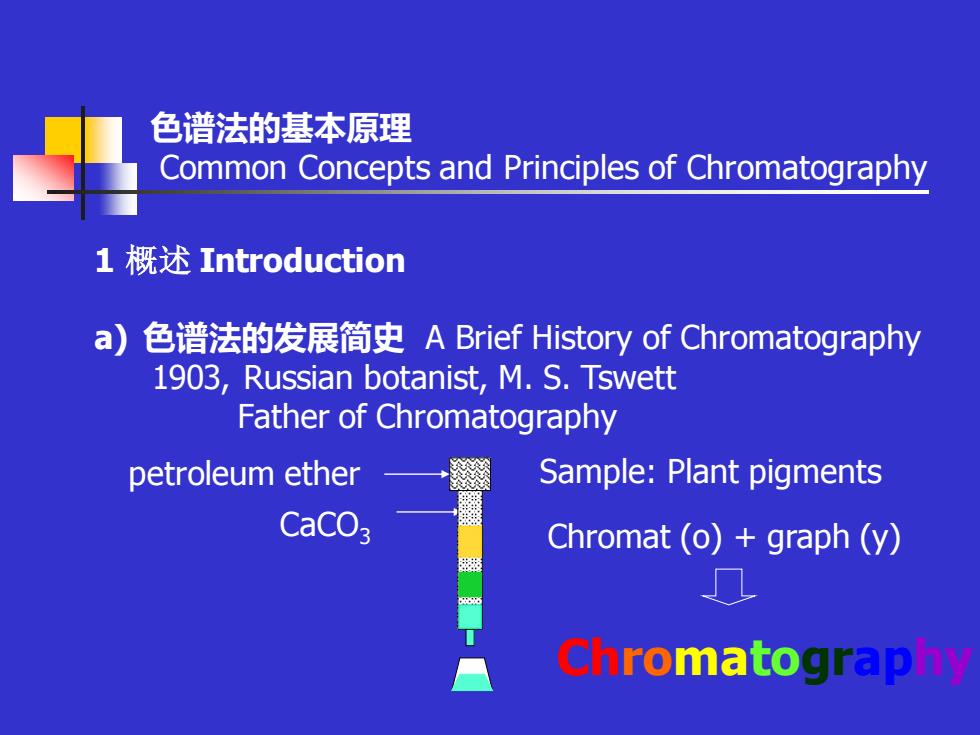
色谱法的基本原理 Common Concepts and Principles of Chromatography 1概述Introduction a)色谱法的发展简史A Brief History of Chromatography 1903,Russian botanist,M.S.Tswett Father of Chromatography petroleum ether Sample:Plant pigments CaCO3 Chromat(o)+graph(y) 口 romatograp
色谱法的基本原理 Common Concepts and Principles of Chromatography 1 概述 Introduction a) 色谱法的发展简史 A Brief History of Chromatography 1903, Russian botanist, M. S. Tswett Father of Chromatography CaCO3 petroleum ether Sample: Plant pigments Chromat (o) + graph (y) Chromatography
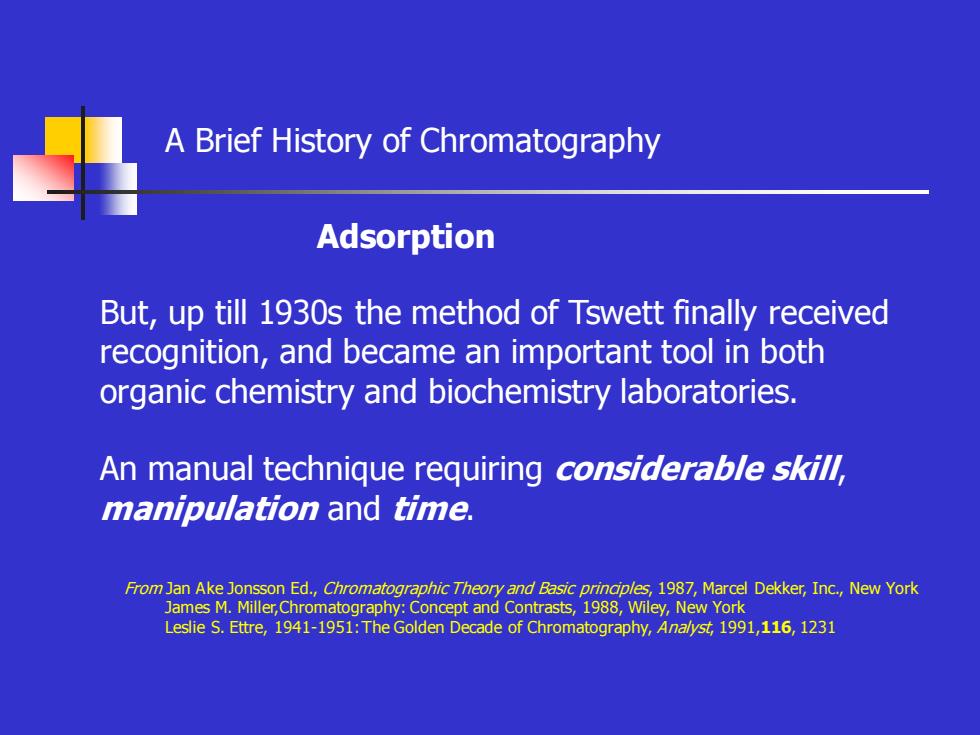
A Brief History of Chromatography Adsorption But,up till 1930s the method of Tswett finally received recognition,and became an important tool in both organic chemistry and biochemistry laboratories. An manual technique requiring considerable skill, manipulation and time. From Jan Ake Jonsson Ed.,Chromatographic Theory and Basic principles,1987,Marcel Dekker,Inc.,New York James M.Miller,Chromatography:Concept and Contrasts,1988,Wiley,New York Leslie S.Ettre,1941-1951:The Golden Decade of Chromatography,Ana/yst,1991,116,1231
A Brief History of Chromatography But, up till 1930s the method of Tswett finally received recognition, and became an important tool in both organic chemistry and biochemistry laboratories. An manual technique requiring considerable skill, manipulation and time. From Jan Ake Jonsson Ed., Chromatographic Theory and Basic principles, 1987, Marcel Dekker, Inc., New York James M. Miller,Chromatography: Concept and Contrasts, 1988, Wiley, New York Leslie S. Ettre, 1941-1951: The Golden Decade of Chromatography, Analyst, 1991,116, 1231 Adsorption
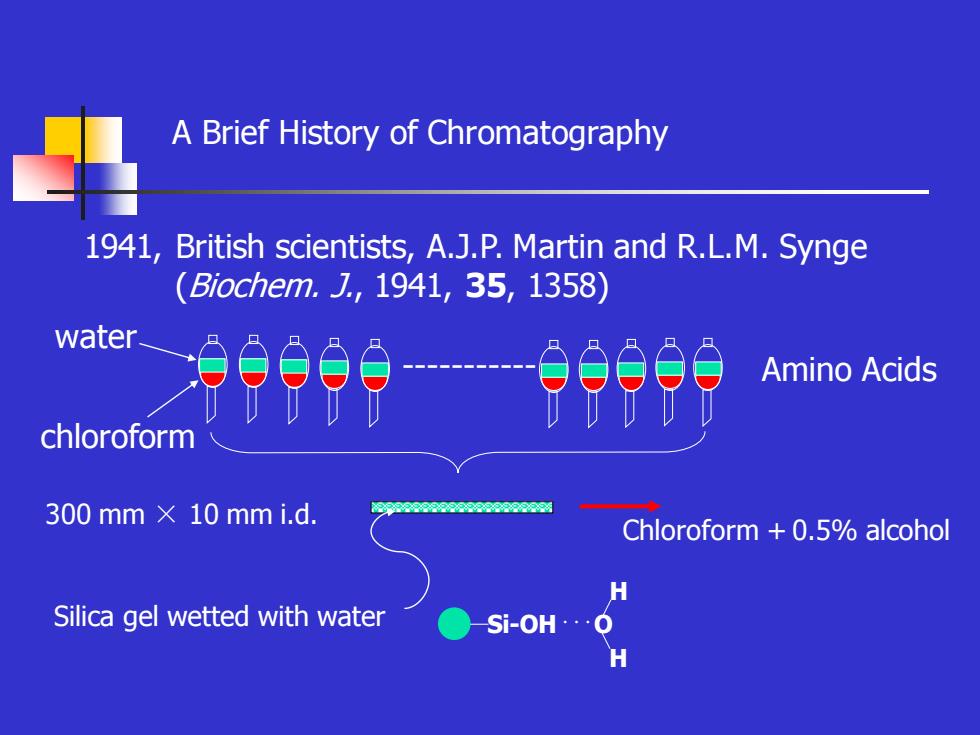
A Brief History of Chromatography 1941,British scientists,A.J.P.Martin and R.L.M.Synge (Biochem.J,1941,35,1358 water 999999 Amino Acids chloroform 300mm×10mmi.d. Chloroform +0.5%alcohol Silica gel wetted with water ●Si-oH
A Brief History of Chromatography 1941, British scientists, A.J.P. Martin and R.L.M. Synge (Biochem. J., 1941, 35, 1358) - 300 mm × 10 mm i.d. water chloroform Chloroform + 0.5% alcohol Silica gel wetted with water Si-OH···O H H Amino Acids
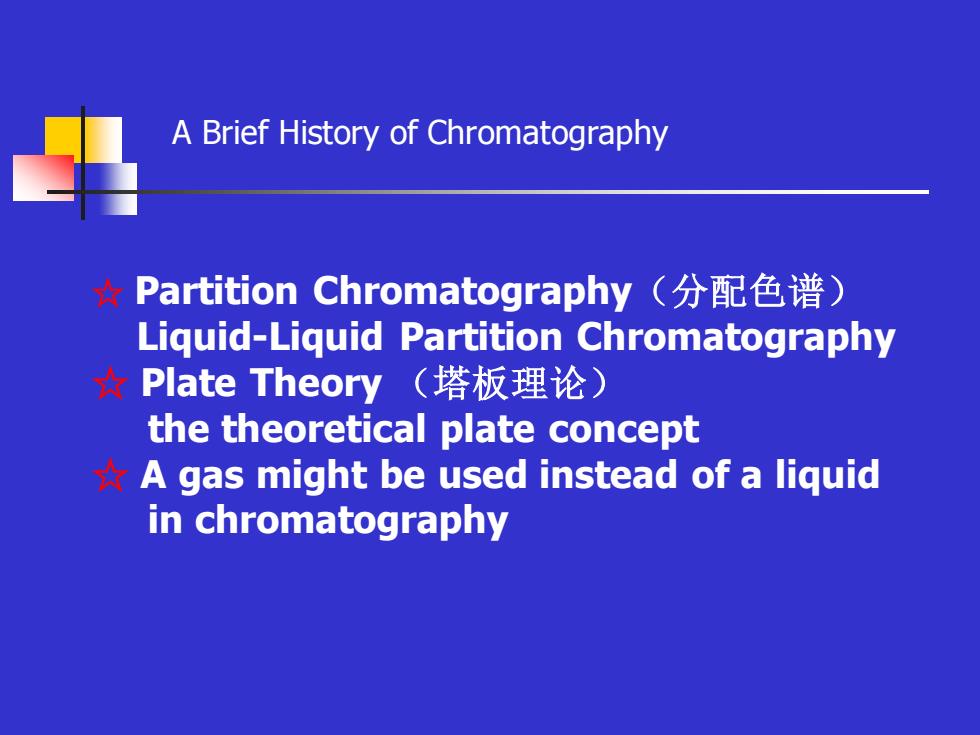
A Brief History of Chromatography ☆Partition Chromatography(分配色谱) Liquid-Liquid Partition Chromatography ☆Plate Theory(塔板理论) the theoretical plate concept A gas might be used instead of a liquid in chromatography
A Brief History of Chromatography ☆ Partition Chromatography(分配色谱) Liquid-Liquid Partition Chromatography ☆ Plate Theory (塔板理论) the theoretical plate concept ☆ A gas might be used instead of a liquid in chromatography

A Brief History of Chromatography 1944,A.J.P.Martin,R.Cinsden and A.H.Gordon developed paper chromatography 1950,A.J.P.Martin and G.A.Howard developed reversed-phase chromatography 1952,A.J.P.Martin and A.T.James Gas-liquid chromatography 1952,A.J.P.Martin and R.L.M.Synge were awarded the Nobel Prize in Chemistry
A Brief History of Chromatography 1944, A.J.P. Martin, R. Cinsden and A.H. Gordon developed paper chromatography 1950, A.J.P. Martin and G.A. Howard developed reversed-phase chromatography 1952, A.J.P. Martin and A.T. James Gas-liquid chromatography 1952, A.J.P. Martin and R.L.M. Synge were awarded the Nobel Prize in Chemistry
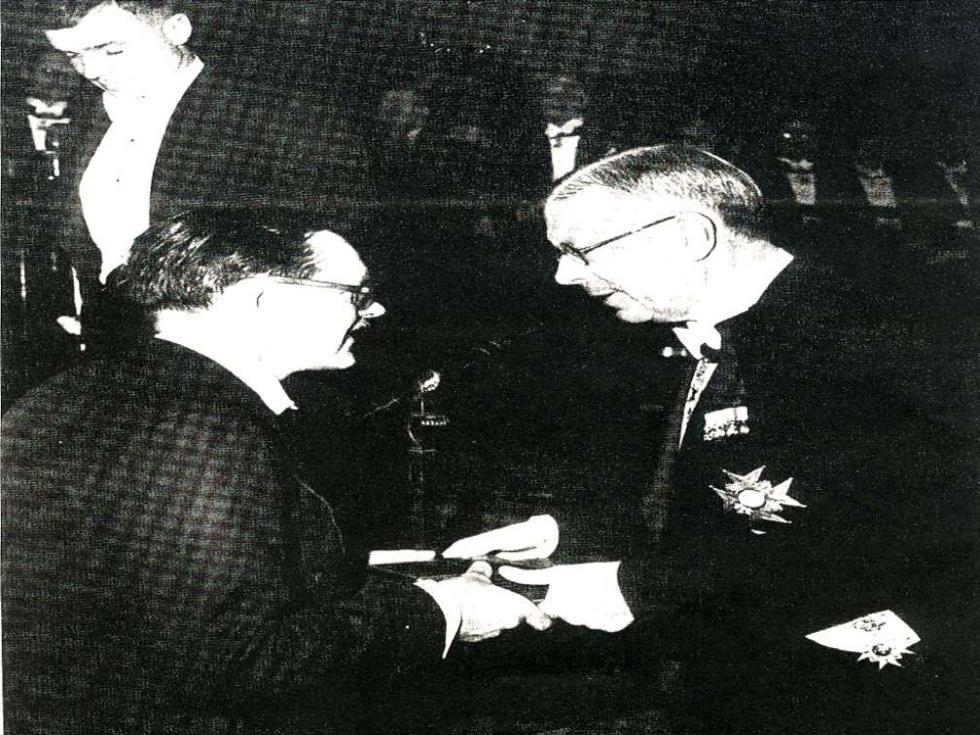
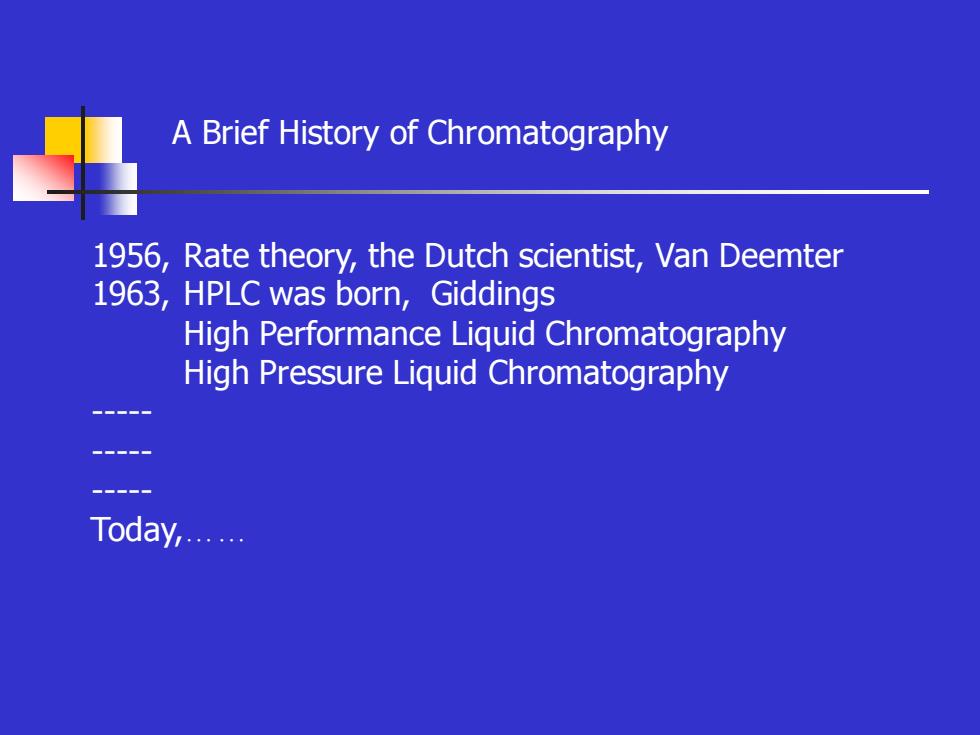
A Brief History of Chromatography 1956,Rate theory,the Dutch scientist,Van Deemter 1963,HPLC was born,Giddings High Performance Liquid Chromatography High Pressure Liquid Chromatography Today
A Brief History of Chromatography 1956, Rate theory, the Dutch scientist, Van Deemter 1963, HPLC was born, Giddings High Performance Liquid Chromatography High Pressure Liquid Chromatography - - - Today

Developing of Chromatographic Technique 2.5 Leucine (a) 20 ('AInba) Isoleucine 05 Valine Methionine Tyrosine L 161 187 215 250 313 350 390415 450 15 200 300 Eluate/ml 2.0 Leucine Isoleucine 1.5 Alanine 1.0 Phenylalanine Glutan acid Valine Proline Threonine Methionine Aspa rtic Serine Ammonia 0.5 Lysine Tyrosine Glycine Arginine Histidine Cystine 13.5 2428 5259 7582 100106117 136 149 163 179 16.526 Solvent change Eluate/ml 1948,8 days separation for 16 amino acids
Developing of Chromatographic Technique 1948, 8 days separation for 16 amino acids